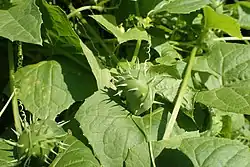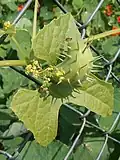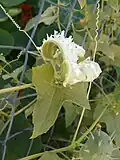Cyclanthera brachystachya
| Exploding cucumber | |
|---|---|

| |
| Foliage and fruit (cultivated) | |
| Scientific classification | |
| Kingdom: | Plantae |
| Clade: | Tracheophytes |
| Clade: | Angiosperms |
| Clade: | Eudicots |
| Clade: | Rosids |
| Order: | Cucurbitales |
| Family: | Cucurbitaceae |
| Genus: | Cyclanthera |
| Species: | C. brachystachya
|
| Binomial name | |
| Cyclanthera brachystachya (DC.) Cogn.
| |
| Synonyms | |
|
Cyclanthera explodens Naudin[1] | |
Cyclanthera brachystachya, the exploding cucumber (but not to be confused with Ecballium elaterium), in the cucurbit or gourd family (Cucurbitaceae), is a herbaceous vine usually grown for its curiosity value, but the fruit is also edible.[1]
Distribution
It is native from Guatemala south to Venezuela, Colombia and Ecuador.[1]
Description
It is a scrambling or trailing annual plant growing up to 3 m long, with hairless stems. The leaves are 5–10 cm diameter, with three or five lobes, and a 3 cm petiole. The unusual fruit are 2–4 cm long, curved but bilaterally symmetrical, bulbous and spiny; they explode when ripe to disperse the 7–9 mm wide seeds.[2] The plant is monoecious, producing both male and female flowers on the same plant in mid-summer.[2]
Cultivation
It is propagated by its puzzle-piece-shaped seed, and grown in conditions similar to other cucurbits like cucumbers and melons. It prefers warm to hot climates with regular watering. Once established the vine can grow quickly up to 3–5 m. Although preferably grown over some kind of support, it can also be grown along the ground.
Food uses
The fruit can be used raw when small (less than 2 cm) in salads, or cooked when mature (2.5 cm, exploded).
Photos
-
-
-
-
-
 Plant
Plant -
 Fruit
Fruit -
 exploded fruit
exploded fruit -
 Shoot
Shoot -
 Tendril
Tendril -
.jpg) Seeds
Seeds -
 Seeds
Seeds
References
- ^ a b c "Cyclanthera brachystachya (DC.) Cogn". Plants of the World Online. Royal Botanic Gardens, Kew. Retrieved 2025-07-19.
- ^ a b Huxley, Anthony (1992). Royal Horticultural Society Dictionary of Gardening. Vol. 1. London : New York: Macmillan Press. p. 798. ISBN 1-56159-001-0.
External links
![]() Media related to Cyclanthera brachystachya at Wikimedia Commons
Media related to Cyclanthera brachystachya at Wikimedia Commons